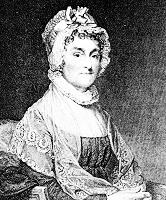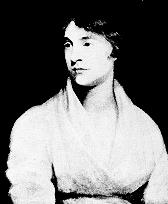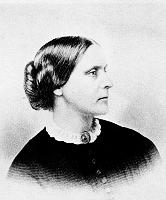|
|
|||||||||
|
|
THE FEMINIST MOVEMENT IN THE UNITED STATES
(left) Abigail Adams (1744-1818) Wife of John Adams,Second President of the U.S. (right) Mary Wollstonecraft (1759-1797) English feminist writer
Susan B. Anthony (1820-1906) The American "Napoleon of the Women's Movement". With her friend Elizabeth Cady Stanton a tireless fighter for women's right to vote. to them than your ancestors. Do not put such unlimited power into the hands of the Husbands. Remember all Men would be tyrants if they could. If perticuliar care and attention is not paid to the Laidies we are determined to foment a Rebelion, and will not hold ourselves bound by any Laws in which we have no voice, or Representation." However, John Adams promptly rejected her plea in no uncertain terms: "As to your extraordinary Code of Laws, I cannot but laugh. . . . Depend upon it, We know better than to repeal our Masculine systems. Altho they are in full Force, you know they are little more than Theory, ... in Practice you know We are the subjects. We have only the Name of Masters, and rather than give up this, which would compleatly subject Us to the Despotism of the Peticoat, I hope General Washington, and all our brave Heroes would fight." This answer, although based on firm convictions, was, of course, insincere. Indeed, the claim that men were masters in name only was a clear insult to Abigail's intelligence. Interestingly enough, Adams revealed the real reason for his stance in a letter to a man, James Sullivan, to whom he explained that only property owners should be given the vote. Since few women owned property in those days, they were to be excluded together with all other economically dependent persons. In short, as John Adams well understood, but failed to discuss with his wife, the oppression of women was rooted in economic conditions. At any rate, the United States of America were founded, and the Constitution was adopted without giving women and slaves their political rights. European women who admired and came to study the new country on visits soon felt their enthusiasm dampened when they encountered the old sexual discrimination and the reality of slavery. For example, the Scottish writer Frances Wright, who published her Views of Society and Manners in America in 1820, and who eventually settled in the United States, decided to fight actively for the freedom of slaves, the emancipation of women, and the rights of the urban poor. In the tradition of the Enlightenment, she also opposed the beginning religious revival in America as reactionary and inimical to human progress. Her social experiments and her personal flamboyance made her many enemies, but many of her criticisms were later vindicated. The English writer Harriet Martineau in her Society in America (1837) offered a perceptive description of life in the New World, but at times during her visit she had to fear for her own life because she supported the abolition of slavery. Sexual inequality and economic injustice were also attacked by the American writer Margaret Fuller whose study Woman in the Nineteenth Century (1845) was one of the most admired books of the time. In the 1820's and 30's various religious and moral reform movements had attracted a growing number of American women. Education, peace, temperance (i.e., the banning of alcohol), and abolition (i.e., the freeing of the slaves) were the first social concerns to which female American Christians could properly devote themselves. Over the following decades this general reform movement flourished and eventually also came to include a new struggle for women's suffrage. Temperance was, of course, of deep personal interest to women, since alcoholic husbands could spend the entire family income on drinks, and their wives had no legal means to do anything about it. Because of their dependent status, they and their children were left unprotected. The interest in abolition, on the other hand, was entirely altruistic. There were a few great black women in the abolitionist movement, such as Sojourner Truth and Harriet Tubman, but its most prominent representatives belonged to the white middle class. Two of the best known abolitionists were the sisters Angelina and Sarah Grimke. Born in South Carolina, they knew slavery firsthand and, after their move to the North, they wrote and spoke extensively against it. In 1838 Angelina Grimke became the first woman to address an American legislative body when she gave an abolitionist speech before the Massachusetts legislature and took the opportunity to raise women's claim to full citizenship. Two other important abolitionists who turned to feminism were Lucretia Mott and Elizabeth Cady Stanton. They were appalled by some episodes of sexual discrimination within the abolitionist movement and, in 1848, therefore organized history's first "Woman's Rights Convention" in Seneca Falls, N.Y.. This convention passed a Declaration of Sentiments which echoed the American Declaration of Independence proclaiming: "We hold these truths to be self-evident: that all men and women are created equal; that they are endowed by their Creator with certain inalienable rights; that among these are life, liberty, and the pursuit of happiness." The document then went on to quote the right to change the form of government and stated: "The history of mankind is a history of repeated injuries and usurpations on the part of man toward woman, having in direct object the establishment of an absolute tyranny over her." The Seneca Falls convention also adopted a set of resolutions, demanding legal and educational reforms and the end of the sexual double standard. Finally, it resolved "that it is the duty of the women of this country to secure to themselves their sacred right to the elective franchise." These demands were quickly attacked and ridiculed by clergymen and male journalists all over the country. Only a few men had foresight enough to recognize the importance of the women's cause and to support it, among them the great black abolitionist Frederick Douglass, who applauded the feminists in his newspaper and appeared as a guest speaker before subsequent women's rights conventions. The women themselves were undaunted by the hostility they encountered and battled on. Elizabeth Cady Stanton found a close friend and ally in Susan B, Anthony, the "Napoleon of the women's movement", whose tireless work and tactical skill won her national recognition and the respect of her adversaries. The beliefs and experiences of these two courageous women were recorded for posterity in the first three volumes of the massive History of Woman Suffrage (1881-86) which they edited together. The American Civil War (1861-1865) brought the women's movement to a temporary halt, but when the abolitionists' goal was finally achieved and the slaves were freed, women seized the opportunity to raise their demands once more. Indeed, they had reason to hope that, together with black men, they would now be granted the vote. However, this hope was soon disappointed. Over and over again, women were told to wait and not to jeopardize the granting of black voting rights by pressing their own demands at the same time. This well-meaning, but shortsighted argument succeeded in splitting the women's movement and reduced its effectiveness for many years. Even worse, women experienced the most serious setback when, in the Fourteenth Amendment (1868), the Constitution for the first time explicitly defined voters as men. Nevertheless, in several other respects progress was being made. Higher education became accessible to females. In the 1830's women's colleges had been founded and, beginning in 1860, some colleges and universities became coeducational. Thus, for example, Elizabeth Blackwell became the first woman to earn a medical degree in the United States. She and her sister Emily, who also became a physician, wrote a book about Medicine as a Profession for Women (1860) and inspired many girls to enter this and other formerly "male" fields of study. Feminists also began to concern themselves with dress reform, the fight against prostitution, better working conditions and higher wages, child labor, unionization, and sexual freedom. Some of these issues proved even more explosive than women's suffrage, and many women remained rather cautious and conservative in discussing them. However, some "radical" feminists were less inhibited. Thus, as early as 1871, Victoria Woodhull spoke of an "inalienable, constitutional, and natural right" to "free love", emphatically rejecting the still prevailing double standard. Emma Goldman, and after her Margaret Sanger, campaigned for birth control. Charlotte Perkins Gilman wrote a penetrating analysis of female oppression in her Women and Economics (1898). This widely read book demanded economic equality for women as the key to political freedom and criticized the existing family structure. One thing was obvious to everyone: In the course of the century the United States had undergone a profound transformation. From an agrarian nation of independent settlers it had changed into a largely urban and industrial society with millions of new poor immigrants and vast social problems. The subjection and disenfranchisement of women only added to these problems, because it made their solution more difficult. Other nations which experienced similar pressures finally took corrective action. New Zealand gave women the vote in 1893, Finland in 1906. The First World War produced social upheavals in Europe and secured the vote for women in the Netherlands and the Soviet Union (1917) and, to a limited extent, in Great Britain (1918). Germany followed suit in 1919. Under the circumstances, the lack of women's suffrage in the United States became an embarrassment. Therefore, in 1920, the country finally adopted the Nineteenth Amendment to the Constitution granting the right to vote to women. A struggle of over seventy years had finally been won. Still, as feminists well knew, this victory was hardly enough, since sexual discrimination continued in many other subtle and not so subtle ways. Unequal pay for equal work, exclusion from influential positions, and innumerable specific legal restrictions denied women equal opportunities in American life. The economic exploitation of women was far from over. The feminist movement therefore supported welfare legislation for maternity and infant care, birth control, stricter labor laws, and government regulation of business. This led to a vicious "red smear" attack by the established powers which denounced feminists as "bolshevik dupes" and "communist conspirators" and accused them of "undermining the family". Primitive and transparent as they were, these smear tactics proved nevertheless to be very successful. Many "respectable" middle-class women were frightened away from the movement and dissuaded from defending their interests. In 1923 the first "Equal Rights Amendment" was introduced in Congress stating: "Men and women shall have equal rights throughout the United States and every place subject to its jurisdiction." However, this proposed Amendment created dissent even within the feminist movement, because it seemed to eliminate some protective labor legislation advantageous to women. A long and heated debate ensued in political conventions, committees, newspapers, journals, and popular magazines. In the long run, nothing came of it but disunity among women and a decline in their political influence. It was not until the 1960's that feminism experienced another upsurge. In 1953 Simone de Beauvoir's The Second Sex had appeared in English translation, an influential book that analyzed the history and implications of female subjection in Western culture. In 1963 Betty Friedan published The Feminine Mystique, openly criticizing the prevailing stereotypical role of the American housewife and mother. Also in 1963 a Presidential Commission issued a report American Women which recommended a number of moderate reforms to improve their status. In response to these and other developments, the National Organization for Women (NOW) was founded in 1966 and soon became the largest and best known of various new women's organizations. NOW almost immediately took up the fight for an Equal Rights Amendment and demanded several other drastic reforms, such as the right to abortion. In the meantime, these demands found much wider support than previously, because many middle-class women had become radicalized through the renewed black civil rights struggle, voter registration drives in the South, and the peace movement against the American war in Southeast Asia. Sexual and reproductive liberation could be discussed more openly, as the whole country had become more sensitive to issues of fairness and individual freedom. In the early 1970's the abortion issue was suddenly settled by the U.S. Supreme Court in the feminists' favor. Moreover, Congress finally passed an Equal Rights Amendment stating "Equality of rights under the law shall not be denied or abridged by the United States or by any State on account of sex." No matter how difficult and lengthy the struggle for ratification may turn out to be, and no matter how often it may fail, feminists are hopeful that the amendment will ultimately be adopted. |



